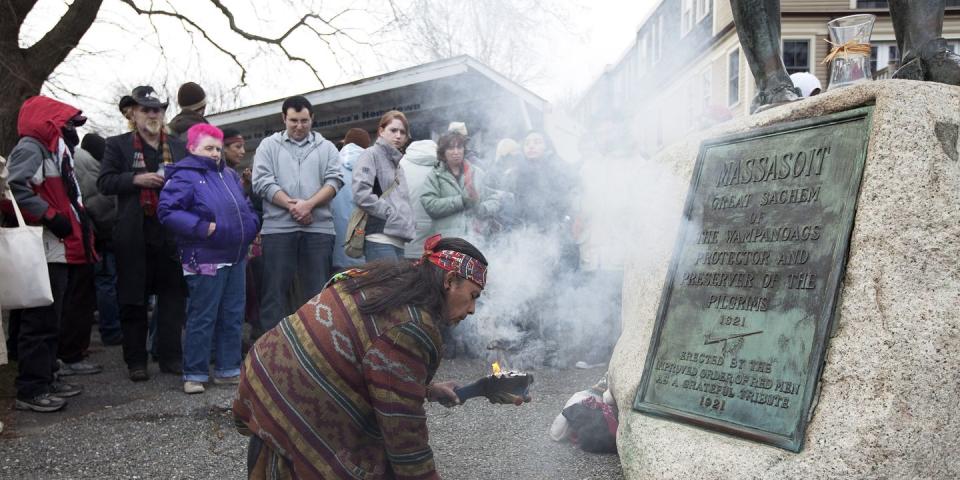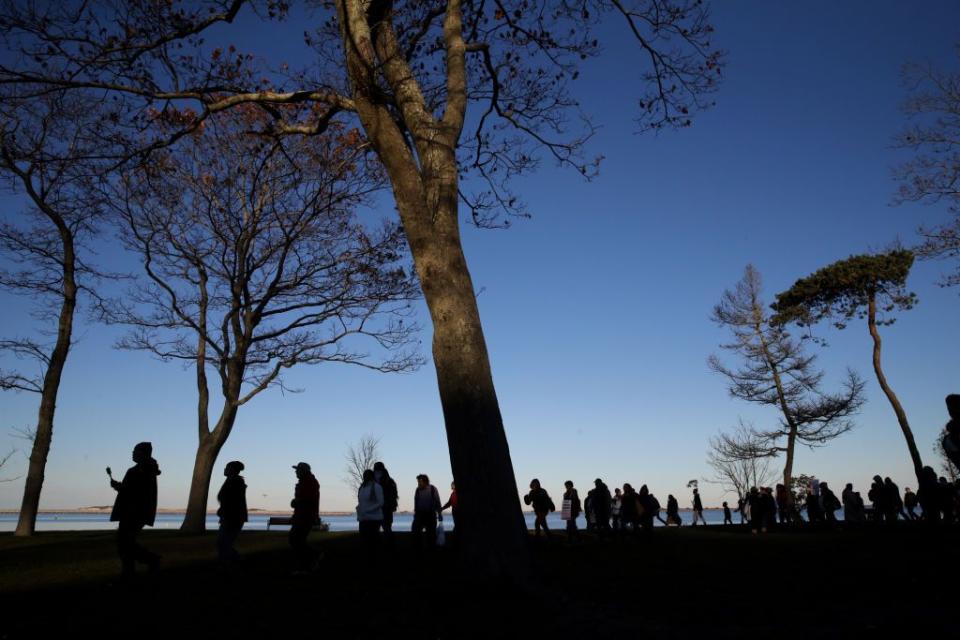The True Story Of Thanksgiving Isn't The One You Learned In School

"Hearst Magazines and Yahoo may earn commission or revenue on some items through the links below."
Most Americans are taught the same story about Thanksgiving—that Pilgrims sat together with Native Americans to share a meal and thank them for helping with a successful first harvest. But that story has been proven to be riddled with mistruths. While you may know that on some level, what's not often discussed is the truth about the holiday's history and the effect it has on many Native Americans.
So consider this just that—an updated history lesson. Learn why some people choose not to celebrate Thanksgiving and how you can support Native people during the holiday season and beyond.
OK, so what's the real story behind Thanksgiving?
You probably have some vague idea that the Thanksgiving holiday is not quite the rosy picture you read about in school, but the "real origins" of the holiday are not clear cut either. We'll give you the best glimpse at what we know, but note: There is a lot of information to digest about this issue and a few supposed origins of the holiday—some of them conflicting. This is the most commonly researched and reported story.
According to The New York Times, the Mayflower did, in fact, bring settlers from England to land which they colonized and renamed Plymouth, MA. In 1621, those Pilgrims did hold a three-day feast, which was attended by members of the Wampanoag tribe. However, typically, when these settlers had what they referred to as "thanksgiving" observances, they actually fasted. So this feast and celebration was known as a "rejoicing," according to The New Yorker. With that in mind, this meal actually being viewed as the "first Thanksgiving" is up for debate with experts.
Though there might have been turkey or some other type of poultry served, there was no pie or mashed potatoes, as we have today. They would have probably had seafood, as well as a Wampanoag dish called nasaump, a porridge made of cornmeal, which the settlers had adopted.
As The Smithsonian points out, discussions of this event are often centered around the settlers, but Native Americans had been on the land for centuries before, and the story from their perspective obviously far predates this feast. When Europeans began coming to what is now known as the United States about four years before the Mayflower arrived, they carried foreign illnesses which killed Native people at exceedingly high rates. That then made it easier for colonizers to take over these lands. There's also the fact that settlers came to the land to kidnap and sell Native Americans into slavery.
The newly settled Europeans also did not invite the Native Americans to their feast. Ousamequin, leader of the Wampanoag Tribe, had declared an alliance with the settlers, and members of the tribe were showing up to honor a mutual-defense pact; they'd heard the Pilgrims shooting their guns in celebration and thought they were in combat. After some talk, they decided to spend three days together and join the feast—but this type of coming together did not become a warm, fuzzy tradition as you may have been taught in school.
From then on, Pilgrims celebrated "thanksgivings" in their traditional way of fasting and praying, according to the The New Yorker. Several times this happened because of the massacres of Native people, including in 1637 when Massachusetts Colony Governor John Winthrop declared a day of thanksgiving after volunteers murdered 700 Pequot people. This incident is also often cited as the first official mention of a "thanksgiving" ceremony, and is another commonly cited origin story for the Thanksgiving we know today.
Various dates of the modern-day Thanksgiving holiday had been declared since then and were celebrated by individual states, but it wasn't until 1863 when President Abraham Lincoln declared the last Thursday in November as a day of Thanksgiving, and the holiday as we know it stuck.
Why is Thanksgiving still controversial?
The atrocities against Native Americans did not end with the diseases or massacres mentioned above, so seeing people celebrating the "positive" myth around Thanksgiving can be frustrating and painful for many, especially Indigenous people. Combine that with the fact that some non-Natives choose to dress up in things like headdresses in "honor" of Thanksgiving, which many see as a mockery of sacred dress.

However, like all groups, Native Americans are not a monolith and have different perspectives on Thanksgiving. For example, some tribes view the holiday as a national day of mourning (shown above); they see it as the day settlers came to their land, spurring decades of violence and mistreatment.
"Thanksgiving day is a reminder of the genocide of millions of Native people, the theft of Native lands, and the relentless assault on Native culture," says the United American Indians of New England. They've marked the occasion as a day of mourning for 48 years, according to Native Hope. "Participants in National Day of Mourning honor Native ancestors and the struggles of Native peoples to survive today. It is a day of remembrance and spiritual connection as well as a protest of the racism and oppression which Native Americans continue to experience.”
Other people, like Sean Sherman, founder and CEO of The Sioux Chef and the author of The Sioux Chef’s Indigenous Kitchen, may also have complicated and painful feelings about the holiday, but are offering up new ways to observe it. He said the following in a piece for Time Magazine, which you should absolutely read in full:
"The thing is, we do not need the poisonous 'pilgrims and Indians' narrative. We do not need that illusion of past unity to actually unite people today. Instead, we can focus simply on values that apply to everybody: togetherness, generosity and gratitude. And we can make the day about what everybody wants to talk and think about anyway: the food.
People may not realize it, but what every person in this country shares, and the very history of this nation, has been in front of us the whole time. Most of our Thanksgiving recipes are made with indigenous foods: turkey, corn, beans, pumpkins, maple, wild rice and the like. We should embrace this."
How can we support Native Americans this holiday and every day?
There are a few different ways to begin, and continue, to uplift Native people and causes close to them, no matter how you feel about the holiday. For example: Seek out Native American authors, activists, artists, and chefs, and support in their work. Listen to and uplift their perspectives and make sure your support goes beyond Thanksgiving and holidays like Indigenous Peoples Day. Learn about causes that are still affecting Native people, such as healthcare, violence against women, and land disparities. Where the last point is concerned, you can find out the Indigenous history of the land you live on by using resources like native-land.ca.
Another simple thing you can do is steer the people in your life away from harmful stereotypes against Native Americans that might appear in your school curriculum, sporting events, or holiday decorations. You can read more about why this cultural appropriation and mockery is hurtful here.
When planning your Thanksgiving meal, consider buying food or other goods from Native American growers in your area, and make a donation to a local Native organization near you. You can find regional resources here. Other nationwide examples include First Nations Development Institute, Native American Heritage Association, and Partnership With Native Americans.
In the spirit of uplifting Indigenous authors, speakers, etc. we've linked some additional resources below:
A Thanksgiving Message from Seven Amazing Native Americans
Native American Brands To Buy From
Five Native American Authors To Read
Indigenous Perspective of Thanksgiving Resources
You Might Also Like

 Yahoo Finance
Yahoo Finance 